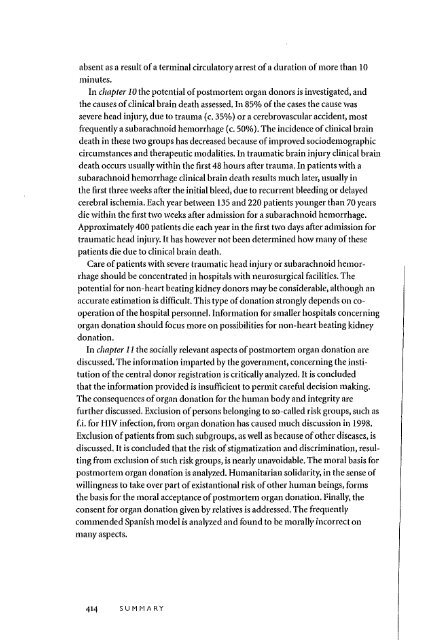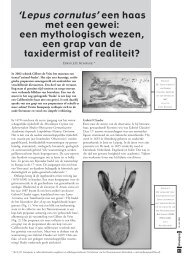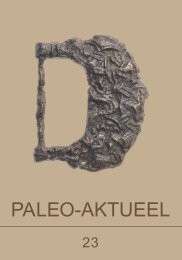- Page 1 and 2:
Geven en nemen
- Page 3 and 4:
Geven en nemen Give and take De pra
- Page 5 and 6:
leh zog meine Fuhre, trotz meiner S
- Page 7 and 8:
Inhoudsopgave IlIleidillg (tlitgall
- Page 9 and 10:
Hoofdslflk 5 Op orgaal/dol/atie voo
- Page 11 and 12:
8.2.1 Handelingen niet in het voord
- Page 13 and 14:
Inleiding (Uitgangspunten, vraagste
- Page 15 and 16:
Relevant voor het doorlopen van dez
- Page 17 and 18:
6 ONDERZOCHTE ONDERDELEN VAN WETGEV
- Page 19:
- anvezige hoest reflex, - aanwijzi
- Page 22 and 23:
1.1 INLEIDING De dead-donor-rule is
- Page 24:
gemeenschap beschouwt de mens als d
- Page 27 and 28:
FIGUUR I Computer Tomografie-sçan
- Page 29 and 30:
dood ziet men na een catastrofale c
- Page 31 and 32:
circulatie in het gehele organisme.
- Page 33:
wetenschap' worden gesteld. Beteken
- Page 38 and 39:
tieloosheid, zoals men deze voor he
- Page 43:
Het onderscheid tussen gegeneralise
- Page 49 and 50:
comateuze patiënten als orgaanbron
- Page 51 and 52:
sproken 77 . Deze al eerder genoemd
- Page 53:
tomen complex bij het beeld van een
- Page 60:
schade aan de hersenstam 102. Dit A
- Page 63:
duidelijk zijn dat men een patiënt
- Page 66:
circulatiestilstand. In de daarop v
- Page 70 and 71:
3 Het uitzenden van informatie naar
- Page 72 and 73:
,weet men bij dit onderzoek niets.
- Page 74 and 75:
voor de definitie van de hersenstam
- Page 76 and 77:
alt'eadl' oCC/lpied bl' tltese coma
- Page 79:
Kanttekeningen bij de whole-brain d
- Page 86:
wel nog niet als dood geaccepteerd.
- Page 89:
Het stimuleren van afgifte van anti
- Page 92 and 93:
nomen dat de samentrekkingen van de
- Page 94:
leerd l7S . MacKenzie (1996): "Tlle
- Page 101 and 102:
gangen 189 en de reactie op het bew
- Page 104:
dat bij elf (19,6%) van 56 klinisch
- Page 107 and 108:
staat. Fujikura et al. (1990) maakt
- Page 109 and 110:
patiënten in het overgrote deel bi
- Page 111 and 112:
cardiovasculaire systeem. In deze p
- Page 113 and 114:
3 Irreversibele en onbehandelbare v
- Page 115 and 116:
nog niet volledig is onderzocht en
- Page 117 and 118:
hoestreflex en zijn oculovestibulai
- Page 119 and 120:
de ambulance wordt zij geïntubeerd
- Page 121 and 122:
gerd. Patiënt A wordt nog gedurend
- Page 123 and 124:
absolute contra-indicatie tot het s
- Page 125 and 126:
pelijke, is op zijn minst verbazing
- Page 127 and 128:
het substraat dat de persoonlijkhei
- Page 129 and 130:
(zinloze) behandeling staken? Nee)
- Page 131 and 132:
uit, laat een ieder zelf bepalen on
- Page 133 and 134:
eerd. Bij sommige patiënten blijve
- Page 135 and 136:
1 !Bij hersendood is de dood van de
- Page 137 and 138:
Klinisch hersen dode zwangere vrouw
- Page 139 and 140:
er enige gevallen bekend waarbij ee
- Page 141 and 142:
4.2 MOET MEN HANDELEN? De algemene
- Page 143:
tussen beide alternatieven. Er kan
- Page 146 and 147:
moeder en foetus en tussen de buite
- Page 149 and 150:
met de voormalige eigenares. De ute
- Page 151 and 152:
niet direct verbonden aan de vrouw,
- Page 153 and 154:
4.8 AFSLUITENDE OFMERKINGEN HOOFDST
- Page 155 and 156:
Op orgaandonatie voorbereidende en
- Page 157 and 158:
Casus 'Salldra' Twaalf oktober 1995
- Page 159 and 160:
werd hen de infauste prognose medeg
- Page 161 and 162:
teneinde de patiënt als orgaandono
- Page 163 and 164:
doeld is en bovendien niet redelijk
- Page 167 and 168:
loos wordt geacht en de patiënt ge
- Page 171 and 172:
therapeutische handelingen aan. Maa
- Page 173 and 174:
Engelse regering zich laten adviser
- Page 175:
de auteurs aan dat het draagvlak vo
- Page 178 and 179:
eademen, dan wachten op de ademstil
- Page 180 and 181:
care to be gil'el/ to lIIe lil/til
- Page 182 and 183:
therapeutische interventie. De meni
- Page 184 and 185:
ook nog toestemmen. Laten we ervan
- Page 187 and 188:
3 These reasolls II/IISt I/Ot apply
- Page 189:
kunnen dulden. Echter in deze situa
- Page 193 and 194:
duidelijk zal worden, van groot bel
- Page 195 and 196:
voor transplantatie nam enorm toe,
- Page 198:
In de literatuur met betrekking tot
- Page 202 and 203:
202
- Page 204 and 205:
ereiding op een non-heart-beating d
- Page 209 and 210:
tiestilstand. Slechts zes (2.4%) ov
- Page 211 and 212:
eerden de uitkomst van 114 patiënt
- Page 214 and 215:
hebben bij het verzoek tot orgaanpr
- Page 216 and 217:
als een thora co tom ie met inwendi
- Page 218 and 219:
4 Waar /iggell de be/ntlgell vall d
- Page 221 and 222:
orgaandonatie staan. Van acht van d
- Page 224 and 225:
lichaam gaat daarom bij het overlij
- Page 226 and 227:
sive care-patiënten zijn. Patiënt
- Page 228 and 229:
staken van deze behandeling het bel
- Page 231 and 232:
neuroloog op het verzoek van de vri
- Page 233 and 234:
de behandeling in diens ogen nuttel
- Page 235:
asis van nutteloosheid in fysiologi
- Page 238 and 239:
citatie geboden moet worden, ongeac
- Page 241:
Terug naar de casus. Uiteindelijk w
- Page 245 and 246:
adequate sedatie en pijnbestrijding
- Page 247 and 248:
die hulpverleners er zelf, persoonl
- Page 249:
eademing, dan zal hen duidelijk gem
- Page 252 and 253:
Twee aspecten met betrekking tot he
- Page 254 and 255:
Zo zagen zij in een kortdurende har
- Page 256 and 257:
gezien kan worden als bij een volwa
- Page 259 and 260:
Non -heart -beating donoren Preserv
- Page 261 and 262:
liter perfusievloeistof per procedu
- Page 263 and 264:
1 Een normatief argument zou kunnen
- Page 266 and 267:
kinderpornografie ons niet meer zou
- Page 268 and 269:
de ingreep niets terugzien aan het
- Page 270:
gebracht worden. Ook preserverende
- Page 273 and 274:
inhoud van ethische problemen. Een
- Page 275 and 276:
ongepast de handelingen zonder toes
- Page 278 and 279:
zO'n der expliciete tO'estemming, m
- Page 280 and 281:
9.1 INLEIDING Belangrijk voor de da
- Page 282 and 283:
schending van de integriteit van li
- Page 284 and 285:
Heleden mogen pas toestemmen tot de
- Page 286 and 287:
angina pectoris. De één zegt bij
- Page 288 and 289:
Het ziet ernaar uit dat het protoco
- Page 290 and 291:
deskundigen uit het gezondheidsrech
- Page 292:
zich positief heeft laten registrer
- Page 295:
eademd. De laatste opname werd geco
- Page 298 and 299:
een actieve levensbeëindiging toet
- Page 300 and 301:
gaandonatie voorbereidende handelin
- Page 302 and 303:
302
- Page 304 and 305:
10.1 INLEIDING Vanaf circa 1970 tot
- Page 306:
kundige veranderingen en onhvikkeli
- Page 311:
Geslachtsverhouding en gemiddelde l
- Page 314 and 315:
vrouw overleed vijf maanden na de t
- Page 316:
casus 'Rob' De 22-jarige Rob rijdt
- Page 319 and 320:
slaagde suïcide met koolmonoxide.
- Page 322 and 323:
wordt een recidiefbloeding voorkome
- Page 324 and 325:
TABEL 4 Aantal verkeersdoden in Ned
- Page 326 and 327:
hetgeen uiteraard ook zijn effect o
- Page 329 and 330:
terwijl de bevolking met OA% meer i
- Page 331:
10.4 HET POTENTIEEL AAN NON-HEART-B
- Page 334 and 335:
om zich al dan niet te laten regist
- Page 337 and 338:
door voorlichting en scholing. Er b
- Page 339 and 340:
Bereidheid tot postmortale orgaando
- Page 341 and 342:
nabestaanden of een specifiek perso
- Page 343 and 344:
eschikking. Dat was in de eerste pl
- Page 345:
drukkelijke wens was? Wat als ik de
- Page 350 and 351:
lichaam worden verricht. Op de dono
- Page 353 and 354:
homoseksueel was en dat Anton grote
- Page 355 and 356:
door het homohuwelijk hebben laten
- Page 357 and 358:
jongen? Dat acupunctuur de oorzaak
- Page 359 and 360:
traal Begeleidingsorgaan voor de In
- Page 361 and 362:
na maart 1998 anders. Tussen maart
- Page 363: zijn dallniet zozeer zelfstalldige,
- Page 366 and 367: estaanden zijn mogelijk nu zelfs no
- Page 368 and 369: ken bij de neuro-intensive care-afd
- Page 370: de organen van de patiënt' is mijn
- Page 374: er niet op ingaat. Dit is waarschij
- Page 380: 106 Onder lll)'driasis worden wijde
- Page 399 and 400: Samenvatting Orgaandonatie als onde
- Page 401 and 402: nagegaan hoe consistent de criteria
- Page 403: de hersendood (met en zonder de bes
- Page 406 and 407: donor is een potentiële orgaandono
- Page 408 and 409: organ donation. But when is a human
- Page 410 and 411: patients having been treated with b
- Page 412 and 413: to be fulfilled when organ donation
- Page 425 and 426: KIMURA, J., H.W. GERBER & W.F.1kCOR
- Page 433: SCHLAG, G., 1973. Kann die Bestimmu
- Page 449: arrest: treatment potentiais. Criti
- Page 467:
U. KROPIUNIGG, 1997. Cr)'ing in hos
- Page 471 and 472:
Dankwoord Allereerst wil ik prof.dr
- Page 473 and 474:
van dit proefschrift door heb ik al
- Page 475 and 476:
Curriculum vitae Erwin Julius Otto
- Page 477:
477








